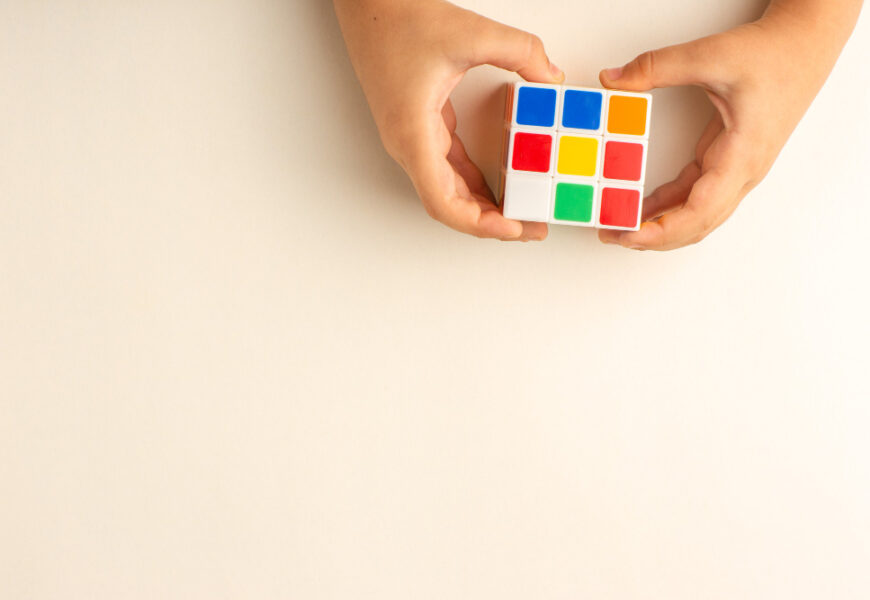The 5x5 Rubik’s Cube, also known as the Professor’s Cube, is one of the most challenging and exciting puzzles for cubers. While it shares many similarities with the classic 3×3 cube, the 5×5 version introduces more complexity with additional edge and center pieces, requiring an advanced level of understanding and strategy. If you’re ready to take your cubing skills to the next level, this comprehensive, step-by-step guide will help you master the 5×5 Rubik’s Cube.
Understanding the 5×5 Rubik’s Cube
Before we dive into solving the 5×5 Rubik’s Cube, it’s essential to understand the structure of the cube. The cube consists of:
- 8 corner pieces: Similar to the 3×3, these corner pieces each have three different colored stickers.
- 36 edge pieces: The edges on the 5×5 are grouped into three pieces: an outer piece and two inner edge pieces.
- 54 center pieces: The centers consist of 9 stickers per face, forming a 3×3 block of fixed center pieces.
Unlike the 3×3 cube, where the center piece determines the color of each face, the 5×5 has multiple center pieces that need to be solved first to help guide the rest of the solve.
Step 1: Solving the Centers
The first step in solving the 5×5 Rubik’s Cube is to solve the center pieces. Once the centers are solved, the cube will behave much like a standard 3×3 Rubik’s Cube.
How to Solve the Centers:
- Start with one face: Choose one color to start with (white, for instance), and begin by solving the center pieces to form a 3×3 square of white on one face. To do this, you’ll need to group the pieces together on one face.
- Pair the center pieces: Pair two center pieces and bring them to the top or bottom layer. Rotate these layers to align the center pieces into a row. Once you have a line of three center pieces, rotate the adjacent face to fix them in place.
- Complete the other centers: After solving the first center, move on to the opposite face (e.g., yellow) and solve it using the same method. Finally, solve the remaining four centers. Ensure that the centers match up with the adjacent faces according to the standard Rubik’s Cube color scheme.
Key Tips:
- Always check the color scheme to ensure you’re solving centers in the right orientation.
- Be cautious not to break previously solved centers as you work on other faces.
Step 2: Pairing the Edges
After solving the centers, the next task is to pair the edge pieces. The goal is to group the inner and outer edge pieces so that each edge behaves like a single edge on a 3×3 Rubik’s Cube.
How to Pair the Edges:
- Find matching edge pieces: Look for two inner edge pieces and their matching outer edge piece. For example, if you’re solving the white-red edge, find the white-red inner pieces and outer edge piece.
- Move the edges to the same face: Once you’ve identified the edge pieces, bring them to the same face without disrupting the solved centers. Use U and L moves to bring the pieces close to each other.
- Solve the edge group: Use the Edge Pairing Algorithm to complete the edges:
- R, U, R’, U’ (Repeat as needed to pair the edge pieces).
- Place the solved edge in the top layer: Once an edge is paired, move it to the top layer so you don’t disturb it while solving other edges.
- Continue pairing edges: Repeat this process until all 12 edges are paired.
Common Challenge: If you’re left with two unsolved edges (commonly referred to as “parity”), you will need to use a special algorithm to fix them, which we’ll cover in the next step.
Step 3: Solving the Parity Errors
Parity errors are unique to the 5×5 Rubik’s Cube and larger cubes. A parity error occurs when two edge pieces remain unpaired after solving all other edges. This situation does not happen on a standard 3×3 cube and requires a specific algorithm to fix.
Edge Parity Fix:
Use the following algorithm to fix edge parity: r U2 l’ U2 r U2 r’ U2 l U2 r2
- r: Rotate the right inner slice upwards.
- l: Rotate the left inner slice upwards.
- U2: Rotate the top layer 180 degrees.
This algorithm should solve the edge pairing parity and allow you to move forward with solving the cube.
Step 4: Solving the Cube Like a 3×3
Once the centers are solved and the edges are paired, the 5×5 Rubik’s Cube can now be solved like a 3×3 cube. If you’re already familiar with solving a 3×3, this step will feel familiar.
Steps to Solve Like a 3×3:
- Cross: Begin by solving the white cross on the top face using the paired edge pieces. This step is the same as in a standard 3×3 solution.
- First two layers (F2L): Insert the corner pieces and edge pieces to complete the first two layers. Again, this process mirrors the method used in a 3×3 cube.
- Last layer (OLL): Orient the last layer using the OLL (Orientation of the Last Layer) algorithms. These algorithms will flip the yellow pieces so that the yellow face is completely solved.
- Permutation of the Last Layer (PLL): The final step is to permute the last layer, positioning the corners and edges into their correct places to solve the entire cube. Use the standard PLL algorithms from the 3×3 method to complete this.
Step 5: Fixing Last Layer Parity Errors
In some cases, you may encounter a last-layer parity error, where one edge is flipped incorrectly after solving the last layer. This parity error does not happen on a 3×3 cube and requires another algorithm to resolve.
Last-Layer Parity Fix:
Use the following algorithm to fix the last-layer parity: r2 B2 U2 l U2 r’ U2 r U2 F2 r F2 l’ B2 r2
- B2: Rotate the back face 180 degrees.
- F2: Rotate the front face 180 degrees.
- U2: Rotate the top layer 180 degrees.
This algorithm should correct the last-layer parity and allow you to finish solving the cube.
Additional Tips for Solving the 5×5 Rubik’s Cube
- Practice Makes Perfect: The 5×5 Rubik’s Cube is more complex than the 3×3, so practice is key. Familiarize yourself with the new challenges of edge pairing and parity errors.
- Work on Algorithms: Memorizing the necessary algorithms, especially the ones for fixing parity errors, will make solving the cube much easier. Focus on mastering one algorithm at a time.
- Be Patient with Parity: Parity errors can be frustrating for beginners, but once you’ve learned the necessary algorithms to solve them, they become manageable.
- Look Ahead: Try to anticipate your next moves during edge pairing and while solving the first two layers to increase your solving speed.
- Use High-Quality Cubes: The 5×5 cube requires more movement than the standard 3×3. Using a high-quality, smooth-turning cube will make the solving process more enjoyable and reduce the chances of lock-ups.
Conclusion
Solving the 5×5 Rubik’s Cube is a rewarding and satisfying challenge for any cuber looking to improve their skills. By following this step-by-step guide, you’ll not only learn how to solve the centers, edges, and corners, but also how to tackle the more advanced concepts of edge pairing and parity errors. With practice and patience, you’ll soon be able to solve the 5×5 cube efficiently and confidently.
Whether you’re a beginner venturing into the world of larger cubes or an experienced cuber looking to refine your skills, mastering the 5×5 Rubik’s Cube will give you a deeper appreciation for the complexity and beauty of this iconic puzzle. So grab your cube, start practicing, and enjoy the journey of solving the 5×5!










